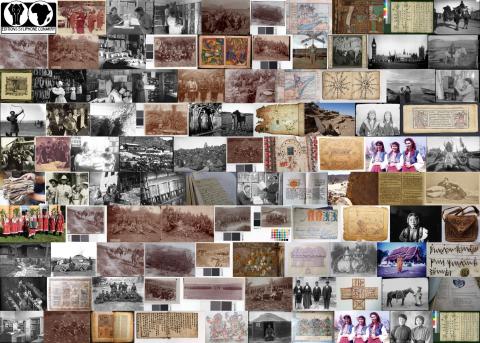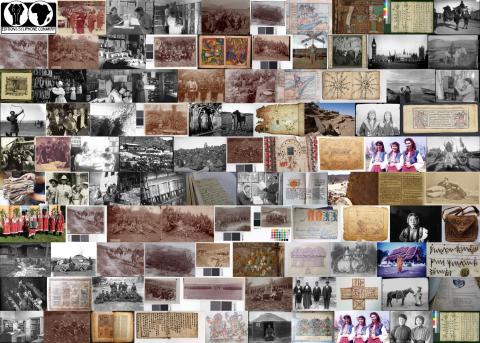
Aims and objectives
The project aims to preserve the unique music and dance archive at the Music Museum of Nepal by transferring the material to a digital format. The nationally and internationally significant archive is highly vulnerable because of its format, the damaging storage conditions and because once destroyed it cannot be replaced.
The instruments, music, songs and dances of the diverse ethnic groups of Nepal are unique in the world. A great many have been lost altogether in recent years. It has taken much work over the last 20 years to identify and track down the key communities and individuals who still have the skills and knowledge. The archive at the Museum is currently the only way that present and future generations in Nepal, and international researchers, can access the playing of instruments that have all but died out; the melodies and lyrics of songs which are no longer sung; and dances and ceremonies which are rarely or no longer performed. Additionally, with the burning of Newari monastery libraries in the 1840s under Jung Bahadur Rana, the written record of music and dance culture in Nepal is very rare.
The archive as a whole consists of audio and visual recordings, books and photographs. There are more than 3,000 hours of recorded songs, instrumental music, dance and sacred ceremonies from pre-modern times. All the recordings were made over the last 20 years (on mini DV, CD, DVD, audio cassette, VHS cassette), but they record artistic and cultural traditions that have continued for many hundreds of years and have not usually been documented in any form. Many of these traditions are now fast disappearing. The archive is unique. This initial one-year project will digitise 250 mini DV tapes and 250 audio cassettes.
There is great urgency to transfer the archive into a secure digital format that can be preserved, shared and disseminated more easily. Much of the content no longer exists in contemporary society. The material is in analogue form, which is in danger of deterioration, as the museum has not the resources to adequately store and protect it from dust, extreme temperatures, mould and silverfish etc. The museum is run on a very tight budget, with no government or regular donor funding, and relies on the passion and expertise of volunteers. Many of the recordings are of people who are no longer alive, and many of them took their skills and knowledge to the grave because they were unable to pass on the traditions. If the archive is damaged it is not replaceable, and the music and dance cultural heritage of many diverse ethnic groups of Nepal will be lost.
The material is very vulnerable. It is stored on open plywood shelves in an unlocked room with no temperature control or air conditioning. The windows are wooden lattice with no glass and no shutters. The building is of traditional brick in a timber frame. There is no ceiling under the roof timbers to insulate or prevent dust and debris falling through. The temperature range over the year is approximately 0 - 40ºC and humidity levels are high during the monsoon. The museum is in the centre of the city, and pollution from traffic fumes and brick factory chimneys has become severe. There is mould growing on the audio and DV cassettes. As a result some of them stick and do not read properly. Many of them have not been looked at since the recordings were made due to an absence of equipment to view them on, so the full extent of the damage is unknown.
The project is modest in scope and will be carried out by Nepalis. Staff at the museum will be trained in the use of the new equipment for digitising and processing the archive, and in completing the listing spreadsheet provided by the British Library. This is a key element of the project because it provides the staff with the capacity and means to digitise more of the archive and to directly catalogue any new material they record over the coming years.
Outcomes
The project digitised the content of 250 mini DV tapes and 250 audio cassettes (a sixth of the current archive). This project has established the importance in Nepal of protecting local archives. For example, the National Theatre has recently asked the Museum to digitise their archive of songs, dances and drama. They have handed over an initial 42 reel-to-reel tapes and work has begun; they have much more material captured in other audio and video formats which they hope can be digitised in the future. The archiving work of the Museum has inspired others to protect and share material in their possession. For example, Nepal TV is in discussion with the Museum about offering their tape archive to the Museum.
The work has sparked academic interest in the material itself. For example, Tribhuwan University, Music Department has expressed an interest in incorporating some of the material into its music curriculum. Furthermore Tribhuwan University has been inspired to start designing an entirely new course in ethnomusicology, and they will look to the Music Museum of Nepal, its friends and its wider contacts for guidance.
People from the previously-’untouchable’ musician/minstrel castes have expressed their pleasure that much of their music culture is being appreciated and will be preserved in perpetuity as well as being made available outside Nepal. It means a great deal to their communities that their heritage is being valued and preserved.
Statement by Dr Anju Upreti, Head of Department of Music, Tribhuvan University, Kirtipur, Kathmandu:
“Nepali folk music has long been a major subject and integral part of Tribhuvan University Music Department's teaching curriculum and is also a rich source of research material for post-graduate students and staff. We consider the archive at the Music Museum of Nepal, especially the audio-visual materials, to be an invaluable resource for our department, and are very grateful that our students and staff members have always been allowed free access for study and research. We congratulate the Museum for their foresight and dedication in building up the archive, and we are very pleased to know that it is now being digitised for ease of access and preservation through the support of the British Library"
- Glossary of some Nepali song genres (created by the project team)





